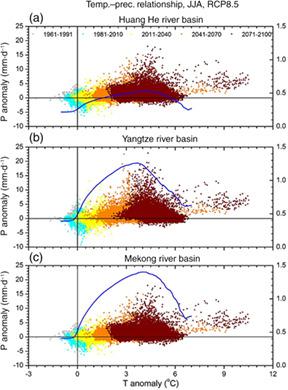当前位置:
X-MOL 学术
›
Int. J. Climatol.
›
论文详情
Our official English website, www.x-mol.net, welcomes your
feedback! (Note: you will need to create a separate account there.)
Future projection of extremely hot and precipitation events over Southeast Asian river basins under RCP8.5 scenario
International Journal of Climatology ( IF 3.5 ) Pub Date : 2021-10-12 , DOI: 10.1002/joc.7410 Reshmita Nath 1, 2 , Yong Luo 3, 4
International Journal of Climatology ( IF 3.5 ) Pub Date : 2021-10-12 , DOI: 10.1002/joc.7410 Reshmita Nath 1, 2 , Yong Luo 3, 4
Affiliation

|
Southeast Asian (SEA) river basins, particularly Huang He, Yangtze and Mekong river basins, are home for large share of global population. The region is experiencing rapid socio-economic development, urbanization and industrialization. Using Community Earth System Model large ensemble data, seasonal mean surface air temperature (SAT) in summer is projected to increase by ~6°C under Representative Concentration Pathway (RCP) 8.5 scenario. As a consequence, in the long term (2071–2100), record-breaking extreme hot and precipitation events are projected to increase by ~90–100% and ~ 60–70%, respectively. The climate mean SAT will increase by 4 ~ 5.5°C by the end of 21st century. Extreme events occur due to the combined influence of external forcing factors and internal variability. The relative strength of both the factors are estimated by signal-to-noise ratio (SNR), that is, the ratio of external forcings and internal variability. Until 2000/1998/2000, SNR < 1 over Huang He/Yangtze/Mekong river basins, that is, internal variability dominates over external forcings, while from 2001/1999/2001 onwards, SNR > 1, that is, external forcings strongly override the internal climate variability. Interestingly, the SAT variability at 50th (mean state) and 95th (record-breaking hot/wet extreme) percentile will decrease significantly as climate warms in the future. It contradicts the existing hypothesis that as the climate warms in the future, variability will increase and weather will get more volatile everywhere. Interestingly, in our analysis, SAT variability appears to decrease over SEA river basins, which is opposite to the current understanding. It makes the result a novel one. We analyse the temperature–precipitation relationship under RCP8.5 scenario, which displays a peak-shaped structure, that is, precipitation is increasing at low–mid-range of temperature rise, while it decreases at higher temperatures.
中文翻译:

RCP8.5情景下东南亚流域极端高温和降水事件的未来预测
东南亚 (SEA) 流域,特别是黄河、长江和湄公河流域,是全球大部分人口的家园。该地区正在经历快速的社会经济发展、城市化和工业化。使用社区地球系统模型大型集合数据,在代表性浓度路径 (RCP) 8.5 情景下,夏季的季节性平均地表气温 (SAT) 预计将增加约 6°C。因此,从长远来看(2071-2100 年),创纪录的极端高温和降水事件预计将分别增加约 90-100% 和约 60-70%。到 21 世纪末,气候平均 SAT 将升高 4 ~ 5.5°C。极端事件的发生是由于外部强迫因素和内部可变性的综合影响。这两个因素的相对强度是通过信噪比 (SNR) 来估计的,即外部强迫和内部可变性的比率。直到 2000/1998/2000 年,黄河/长江/湄公河流域 SNR < 1,即内部变率优于外部强迫,而从 2001/1999/2001 年起,SNR > 1,即外部强迫强内部气候变率。有趣的是,随着未来气候变暖,第 50 个(平均状态)和第 95 个(创纪录的高温/潮湿极端)百分位数的 SAT 变异性将显着降低。它与现有的假设相矛盾,即随着未来气候变暖,变异性将增加,各地的天气将变得更加不稳定。有趣的是,在我们的分析中,SAT 变异性似乎在 SEA 河流域减少,这与现在的理解相反。它使结果变得新颖。我们分析了RCP8.5情景下的温度-降水关系,呈现出峰形结构,即降水在温升的中低区间增加,而在较高温度下减少。
更新日期:2021-10-12
中文翻译:

RCP8.5情景下东南亚流域极端高温和降水事件的未来预测
东南亚 (SEA) 流域,特别是黄河、长江和湄公河流域,是全球大部分人口的家园。该地区正在经历快速的社会经济发展、城市化和工业化。使用社区地球系统模型大型集合数据,在代表性浓度路径 (RCP) 8.5 情景下,夏季的季节性平均地表气温 (SAT) 预计将增加约 6°C。因此,从长远来看(2071-2100 年),创纪录的极端高温和降水事件预计将分别增加约 90-100% 和约 60-70%。到 21 世纪末,气候平均 SAT 将升高 4 ~ 5.5°C。极端事件的发生是由于外部强迫因素和内部可变性的综合影响。这两个因素的相对强度是通过信噪比 (SNR) 来估计的,即外部强迫和内部可变性的比率。直到 2000/1998/2000 年,黄河/长江/湄公河流域 SNR < 1,即内部变率优于外部强迫,而从 2001/1999/2001 年起,SNR > 1,即外部强迫强内部气候变率。有趣的是,随着未来气候变暖,第 50 个(平均状态)和第 95 个(创纪录的高温/潮湿极端)百分位数的 SAT 变异性将显着降低。它与现有的假设相矛盾,即随着未来气候变暖,变异性将增加,各地的天气将变得更加不稳定。有趣的是,在我们的分析中,SAT 变异性似乎在 SEA 河流域减少,这与现在的理解相反。它使结果变得新颖。我们分析了RCP8.5情景下的温度-降水关系,呈现出峰形结构,即降水在温升的中低区间增加,而在较高温度下减少。


















































 京公网安备 11010802027423号
京公网安备 11010802027423号